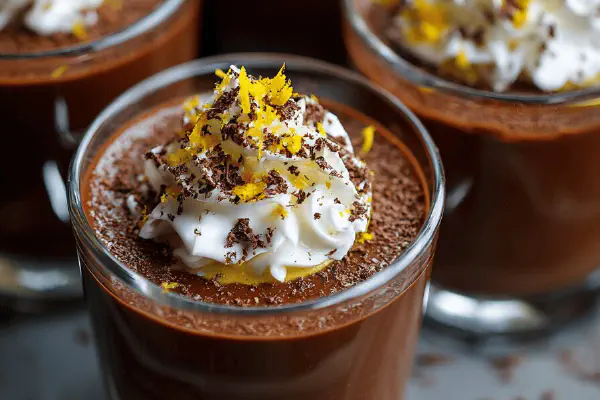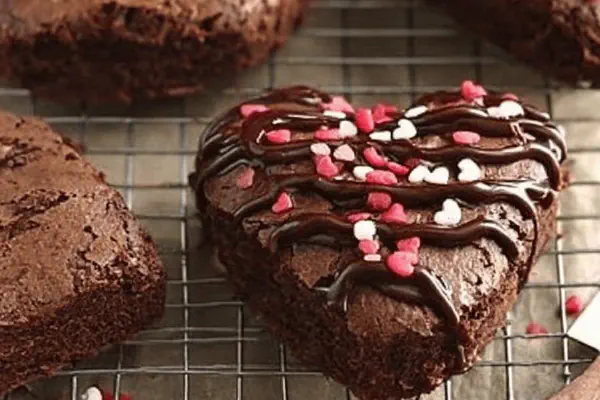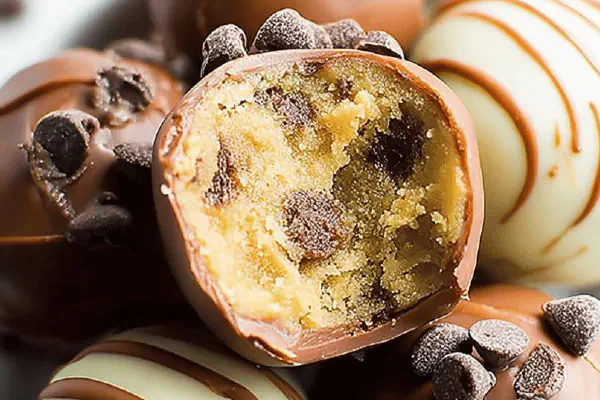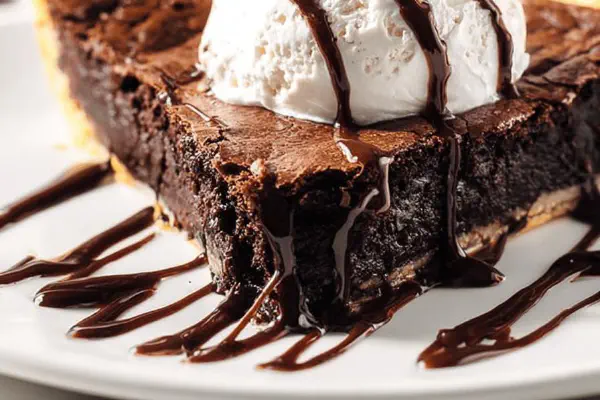Chocolate Cream Pots with Orange

By Emma
Certified Culinary Professional
Ingredients
- 120 g dark chocolate chopped roughly
- 45 ml sugar
- 7 ml cornstarch
- 4 egg yolks
- 220 ml milk
- 220 ml 35% cream
- zest of 1 orange
- whipped cream optional
About the ingredients
Method
- 1. Place chopped chocolate in bowl. Set aside.
- 2. In saucepan off heat, whisk sugar and cornstarch. Add egg yolks, beat until combined. Gradually stir in milk and cream along with orange zest.
- 3. Heat over medium, stirring constantly, scrape bottom. Bring to boil, simmer until custard thickens about 6-8 minutes. Timing varies, watch closely.
- 4. Strain custard through sieve over chocolate. Wait 2 minutes. Stir vigorously until smooth and glossy.
- 5. Pour into 6 small ramekins, about 125 ml each. Cover with plastic wrap. Refrigerate minimum 1.5 hours or better chilled 3 hours.
- 6. Serve cold with optional whipped cream dollop.
Cooking tips
Chef's notes
- 💡 Mix sugar and cornstarch first dry to avoid lumps. Whisk egg yolks into mix gently. Cold milk and cream go in slow. Stir constantly over medium heat. Custard scalds quick near boiling so watch. Use fine sieve after cooking to catch cooked bits, zest remnants. Pour warm custard carefully on chocolate. Wait two minutes before stirring. Aggressive whisking breaks shine and texture. Cover ramekins with plastic to stop skin. Chill minimum one and half hours but longer better for firm set.
- 💡 Temperature control key. Medium heat enough. Too hot burns milk, curdles eggs fast. Stir often scrape bottom, no freeze spots. Custard thickens around 6-8 minutes, varies by stove. Timing not exact. If lumps appear after cooking, strain again or blend quickly. Chocolate piece size affects melting time; rough chop recommended. Orange zest replaces vanilla—adds bright citrus, not sweet. Serving cold keeps texture firm, aroma intact. Whipped cream optional but cuts richness, balances tangy edge.
- 💡 Egg yolks thicken custard but add risk of scrambling. Whisk dry ingredients with yolks first reduces egg cooking too fast. Gradually add cold liquids while whisking. Keeps temperature uniform. Before heating, mixture should be smooth and combined. Once on heat, stirring nonstop, scrape bottom edges. Custard thickens once bubbles form, but must simmer gently, not boil hard. Strainer removes cooked yolk bits. Pouring on chocolate unmelted gives gentle melt without grit. Patience at melting stage yields glossy custard, not grainy.
- 💡 Scaling ingredients down from classic recipes keeps balance. Less chocolate (120g vs 170g) lowers bitterness, prevents heaviness. Sugar cut to 45ml keeps tart from orange zest present, avoids sweetness overload. Cornstarch slightly more to stabilize thinner custard from less sugar. Milk and cream volumes balanced for texture, not too rich or thin. Use 35% cream for best mouthfeel. Zest of one orange, finely grated, provides aromatic lift. Keep zest pieces small to avoid textural issues in custard.
- 💡 Plastic wrap on ramekins seals moisture, prevents thick film on top. Chill at least 1.5 hours but 3 hours better for firmer texture. Don’t rush cooling. Custard thickens as it chills. If texture too soft, chill longer. Whipped cream adds fat contrast, volume lightens richness. Add just before serving. Clean rasp or grater for zest fine enough, no white pith. Over zesting makes bitter. Timing at heating step crucial. Stir vigorously but not harsh when folding chocolate after custard strain.
Common questions
Can I use a different chocolate?
Dark chocolate best for bitterness, melts well. Milk chocolate softer flavor, watch melting time, sweeter. White chocolate adds fat, changes custard texture. Adjust sugar if sweeter chocolate used. Don’t use candy chips, poor melt. Experiment small batch first. Chocolate quality affects final taste, glossy texture depends on cocoa solids and fat content. No vanilla here, orange zest replaces aromatic.
Why does custard sometimes curdle?
Heat too high main cause. Stirring stops egg curdling by spreading heat. Add milk creams cold slows cooking. Cook medium to low heat only. If scrambled, strain before pouring on chocolate or reheat gently. Egg yolk ratio matters, four yolks enough to thicken, too many risk lumps. Cornstarch helps stabilize custard. If lumps still form, strain again or blend briefly.
How long can I store these pots?
Keep refrigerated covered. Up to three days max. Longer loses texture, absorbs fridge odors. Cover prevents skin on custard. Freeze not suggested, texture changes when thawed. For storing, cover ramekins with plastic wrap directly on surface to avoid thick skin formation. Chill minimum 1.5 hours before serving, better after 3. Leftover pots best eaten cold straight from fridge.
Can I prepare ahead?
Yes. Make custard, chill overnight. Keeps shape well if covered. Keep whipped cream separate, add before serving. Re-whip cream if needed. Do not freeze custard as flakes and separates when thawed. For better set, chill minimum 3 hours. Prepare steps one and two ahead, cook and strain close to serving time if possible—but overnight chilling convenient. Using plastic wrap tight on surface keeps custard fresh.



